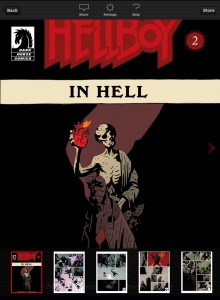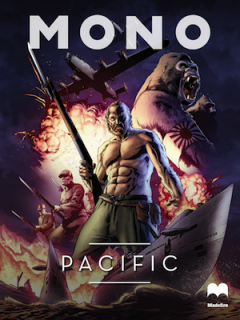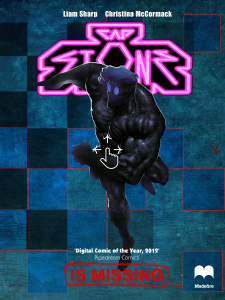“Our number one goal is a seamless cinematic experience” Wendell Yuponce on soundtracking Madefire motion books
 In the world of Madefire motion books there is more to a digital comic than just great art and compelling stories – there’s sound as well! Whether it’s creating the right ambience and mood for a character’s inner turmoil or soundtracking an epic battle, Madefire‘s audio experts like Wendell Yuponce bring life and soul to the static pages of some of the motion book publisher’s biggest titles. We catch up with Wendell to find out the secrets to a good motion book soundtrack.
In the world of Madefire motion books there is more to a digital comic than just great art and compelling stories – there’s sound as well! Whether it’s creating the right ambience and mood for a character’s inner turmoil or soundtracking an epic battle, Madefire‘s audio experts like Wendell Yuponce bring life and soul to the static pages of some of the motion book publisher’s biggest titles. We catch up with Wendell to find out the secrets to a good motion book soundtrack.
 Tell us a bit about the process of adding sound to a motion book? At what stage in the creative process do you get to work your magic?
Tell us a bit about the process of adding sound to a motion book? At what stage in the creative process do you get to work your magic?
WY: All the sound work is initiated after the primary visual work has been created, so when our sound team receives the book it is already published internally to iPad as well as the Madefire tool. Many times the sound team will be given advance access to a new title coming to the Madefire Motion Book format, but it will depend on whether the title is an existing franchise such as Transformers or an original.
How do you decide the direction a soundtrack will go and what sort of sound will suit a certain title?
WY: We start out with pre-production discussions regarding philosophical approaches to the role and character of sound. In the instance of Hellboy In Hell, it was decided that the reference points were Exorcist 3 and Altered States which had integrated sound effects and ambiences that were indistinguishable as separate elements from the score. Whereas with Transformers, much of the sound design involved a sledge hammer and the destruction of many objects under the purview of an open microphone.
When it came to Injustice: Gods Amongst Us (Batman vs. Superman), there was an enormous amount of musical pedagogy dating back to the original television series which informed how the music and sound would interact.
How much does your approach differ for the licensed titles compared to Madefire originals?
WY: For licensed titles such as Hellboy in Hell, Transformers or Injustice the respective publishers approach sound as something inseparable from the full experience. This means the sound team is allowed to make our case with a fully implemented sound display before DC, Top Cow, IDW, Dark Horse or others render their final opinion. This is much different then film, television or commercial which involves great amounts of input and micro-management at almost every stage of development. In those instances, the ability to verbally describe the work in abstract long before realization is a very important part of the process.
To the contrary, Madefire Motion Books are only reviewed after a completed sound pass and thus more likely to convey a cohesive vision without confusion via semantic misunderstanding. The product moves so quickly through this medium that the largest compliment is usually the arrival of the next issue without any ongoing discussion.
How many people are there working on sound development for Madefire and how long does it take to soundtrack an episode?
WY: The sound effects are installed by our wonderful sound effects team, Chris Famaausilli, Colten Becker and new assistant, Bryan Beeson. Each issue is reviewed via iPad to get a real time average on how long a reader might stay on a particular page or click point within it. For accuracy, this demands at least 2 reads or more.
After the book has been broken down into seconds for musical transitions within a page (or page-to-page), music is then created and/or edited. There is often an ongoing dialogue within the sound effects team regarding conflicts where sound effects might be fighting music and in some instances, decisions might be made where an event is better served by nothing but a sound effect. For example, in the upcoming conclusion to Sherlock Holmes The Greek Interpreter, page 5 starts with a train visual and train sound and the music only starts after that panel is cleared.
Once the music is supplied by our tool mixer, Jerry Yamashita, he will do the final mix adding any quality control opinions to the mix. After the mix, it will again be published internally for approval by myself as well as by executive producer, George Englund. Lastly, either Joe Elardy, Ben Abernathy, Liam Sharp, Kevin Buckley, Ben Wolstenholme or all of them collectively will weigh in for final approval and comments as to any requested changes.
So how long does this whole process take?
WY: This entire process is sometimes happening under extreme deadlines, as in the instance of Injustice, which often times comes in with a required turnaround of 48 hours or less! It is a point of pride within the sound team that after over 100 issues and counting, the requested revisions can be counted on one hand.
 Which soundtracks are you proudest of producing?
Which soundtracks are you proudest of producing?
WY: The approach has always been to brand each story as sonically unique so that makes it hard to rank one score above another. Still, it’s hard not to single out Injustice just by pure scope and size of the work involved. Recent inventory places that library alone at 250 plus pieces of music that were created amidst the other series in approximately 9 months since the first Madefire Motion Book in December 2013. In spite of this, I must say I tend to be in love with the most current work which happens to be something that you recently reviewed – Mono: Pacific #1. I am loving the chance to combine epic orchestra with log drums and Indonesian Gamelan (actually a sampled beer keg!).
If you could add sounds and motion to any current or past comic (series or individual episodes) which would you pick and why? (Madefire and non-Madefire)
WY: I was a fan of many Marvel series in my high school days of the late 70’s. If I could work on a series following Galactus’ and his various heralds including Silver Surfer, Nova and Terrax perhaps with the heralds creating their own super team, I would gladly drop everything to see that part of the Marvel universe unfold.
As for the more immediate, I would love to see DC expand their motion book offerings to other Justice League characters such as Flash, Hawkman, Aqua Man and the plethora of others.
What is the secret to a good soundtrack for a motion book? Lots of effects that amplify the action or incidental music and sounds which capture a mood?
WY: As mentioned previously, the combination of sound effects and music along with each having it’s own variable permutations can be quite the devil in the details. In Hellboy in Hell the sound effects are purposely designed to carry equal weight with the music whereas in Injustice the music is definitely the largest sonic imprint. The secret is pre-production discussion and conceptualisation. Within Treatment: Seoul the sound effects are more prominent with the music being minimal and beat based while in Heroes Club, the music is almost 90% of overall content.
However these choices aren’t necessarily driven by the sound team. The way things are illustrated and what is drawn almost always dictates the aforementioned choices. To elaborate, all sound effects are prompted mostly from direct or implied obligation. For example, within Dracula’s Guest there are horses both mentioned in text as well as illustrated in certain panels thus cantering horses figures heavily within the sound design. Even within instances that the horses aren’t mentioned or seen, there are nervous horses shuffling to indicate danger or foreboding. Music on the other hand has no rationale within the real world. When a policeman is in pursuit of a criminal, the musical strains of a 90 piece orchestra doesn’t magically waft overhead as bystanders whip out their cell phones to capture the moment.
Music does however evoke strong emotional responses that reside within our own memories and nostalgia. In lieu of additional visual or verbal context, music can portend a sense of connection or loss more effectively with only a slight texture or melody. Although there is no universal rule for finding the proper combination for a sound soundscape for your Madefire Motion Book, there is much that can happen in understanding the purpose and relationships that each of these component contributes towards the larger artistic intention.
 Can you tell us a bit about your background and how you got involved with the Madefire team?
Can you tell us a bit about your background and how you got involved with the Madefire team?
WY: I am university trained as both a performing jazz drummer and as a contemporary composer. Adding to that I was mentored into the industry via two well established composers that gave me the task of “ghosting” their work on lesser contracts. It was this relationship that led to the introduction with my current executive producer, George Englund, who was at the same time post production supervisor for a very large television production studio. After working together for a good time, then losing touch after I moved away from Los Angeles, we reconnected in the early 2000’s which led to Madefire which is located in Berkeley not far from my new home in Northern California.
What do you think the next step in developing sound for motion books is going to be?
WY: The next evolution will largely depend on the state of the tool. Madefire is the most elegant tool for creating Motion Books but by their own admission, it is far from a perfect device. The sound implementation can be quite arcane at times, especially when all of us at sound come from working in fully implemented recording technology.
The short term future for the tool may very well be some basic post-audio enhancements that you would typically find within a basic music software program. Also, increased bandwidth will allow a more high fidelity experience as well as enhanced visual imagery.
It’s hard to imagine the next progression for the distant future but perhaps it will be more real time connectivity in terms of variable “clickable” response. Currently any prompt triggers the same response whether you read fast or more slowly as you dwell upon the art. What would be fantastic is a way for the software to know within a certain elapsed time which sound to trigger next thereby lending an even more seamless transition of both music and sound effects. Our number one goal is a seamless “cinematic” experience on par with any entertainment medium the reader may experience throughout their day.
How would you like to push the boundaries of digital comics further
WY: We are constantly striving to push those boundaries within the software and within ourselves as artists. For now, the software is designed to move both backwards and forwards. Backwards in the sense that many former titles dating back to the early days of comics are being scanned and archived within the digital realm. It is only after all of the archival material is rescued that the software will exclusively look forward as the audience begins to expect more from their comic reading experiences. The trick for us as creators is to meet that challenge head on, first by rendering work that needs no apology regardless of limitation and secondly by constantly adapting the experience to bring not only nostalgia but immediacy.
You can download the latest Madefire motion books from the Madefire app for iOS, Windows and Android, as well as via their channel on deviantART.


